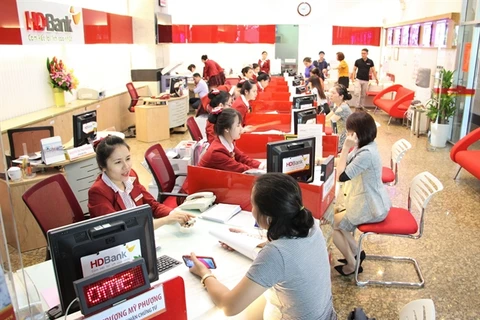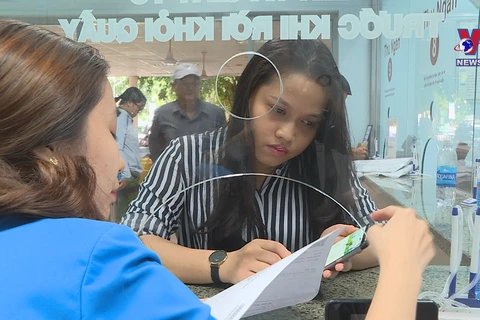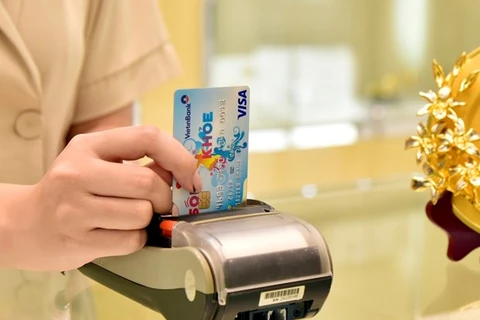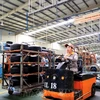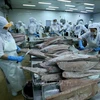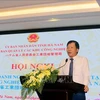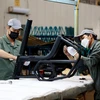Hanoi (VNA) – The COVID-19 pandemic has contributed to forming online shopping and online payment habits, a trend that is likely to continue after the pandemic, held experts.
The overall target of the project to develop cashless payments in Vietnam between 2016-2020 is to gradually change payment habits in society and reduce the ratio of cash in circulation to gross domestic product (GDP) and total means of payment.
However, so far, Vietnam has been one of the countries with the lowest ratio of cashless payment in the region. A survey on cashless payments in six ASEAN countries (Singapore, Thailand, Malaysia, Indonesia, Cambodia and Vietnam) by the International Data Group (IDG) showed that cash payments in Vietnam counted for 79 percent.
[Online payments: COVID-19 urges banks to change]
Habits are hard to change and comprehensive solutions from authorised agencies are required.
Facing the recent COVID-19 pandemic, consumers have been aware of benefits of cashless payments, evidenced by the significant rise of online transactions.
Therefore, analysts held that this is a rare opportunity for banks and businesses to promote cashless payment solutions.
Since the beginning of this year, due to the development of the pandemic, online payment demands have rocketed as many families have chosen to shop online, especially during social distancing. Payment using mobile apps and contactless cards have become more popular.
Smartphones become shopping tools
Pham Thanh Nga, a local in Long Bien district in Hanoi said that she is very careful when choosing food for her family. She goes to the market every day to buy fresh food and avoid frozen food. But the COVID-19 pandemic has prevented her from going out, forcing her to explored online shopping.
“At first, I was worried that the stuff I bought online would be low quality, but I was surprised at the quality. More importantly, when shopping online, I often pay through bank transfer without having to withdraw money from an ATM,” said Nga.
Like Nga, Dong Van Thoa from Ba Dinh district in Hanoi said that cash payment was once his everyday habit. But since the pandemic broke out, he switched to online banking and QR payment apps on his smartphone. Thoa has encouraged and supported his wife to do the same, excepting when paying for goods at traditional markets or when the payment is too small.
Cash payment limits have been supported by many consumers like Nga and Thoa. Supermarkets and shops have also shown an active response.
About 70 percent of shoppers in supermarkets like Vinmart, Intimex and Hapro use cashless payments, which are encouraged by the supermarkets.
In the retail sector, many large firms have caught the trend by offering smart utilities and giving customers a convenient and safe shopping experience using technology during the pandemic.
Today, people not only shop for fashion products online, but they buy fresh food and necessities through apps without going to the market.
During the COVID-19 pandemic, VietinBank and BIDV have worked with VNPAY to promote “VinMart: supermarket at home” in the iPay Mobile app, allowing customers to shop safely.
Surveys showed that Vietnamese consumers often shop from 12:00-14:00 and 20:00-22:00, using their phones during lunch break and before going to bed.
A survey by Department of E-Commerce and Digital Economy under the Ministry of Industry and Trade indicated that 36 percent of people surveyed said that they used the Internet for 3-5 hours each day. Laptop and smartphones remained the major means for Internet users with respective ratios of 75 and 65 percent.
Nguyen Ngoc Dung, Vice President of the Vietnam E-Commerce Association said that access to e-trading floors rose 150 percent year on year, mostly on shopping channels like Shopee, Lazada, Tiki and Sendo.
Shopee reported 43.15 million visits a day, followed by Tiki with 24 million visits, Ladaza with 19.76 million visits, and Sendo with 17.59 million visits.
According to Dung, people have restricted to go out for restaurants, while storing more food, ordering food online and enjoying entertainment at home. The survey showed that 83 percent of people went out less often, while 65 percent limited themselves from going shopping, and 26 percent ordered food through apps.
“COVID-19 has led to a habit of online shopping and payment online or through apps, which is likely to continue after the pandemic,” said Dung.
Pham Tien Dung, head of the Payment Department under the State Bank of Vietnam, cited statistics showing a rise in cashless payments. He said that payments through mobile apps of banks increased 198.8 percent in transactions and 21.9 percent in value compared to the same period in 2019. Domestic payments via banking cards also rose 26.2 percent in the number of transactions and 15.7 percent in value, he said, adding that payments on the Internet were also up 3.2 percent in volume and 45.7 percent in value./.



